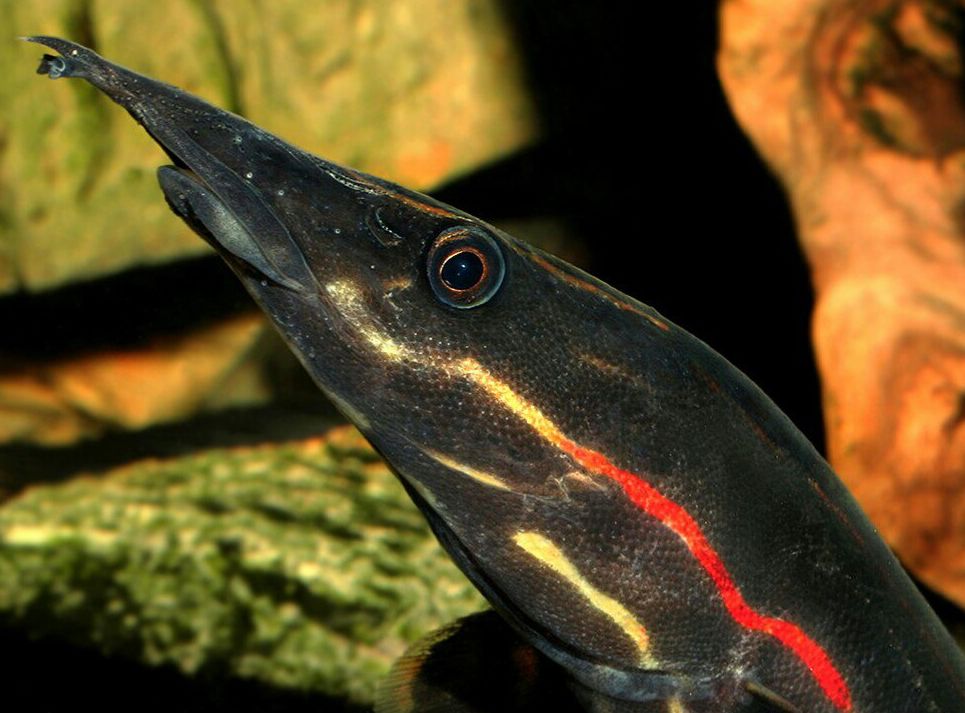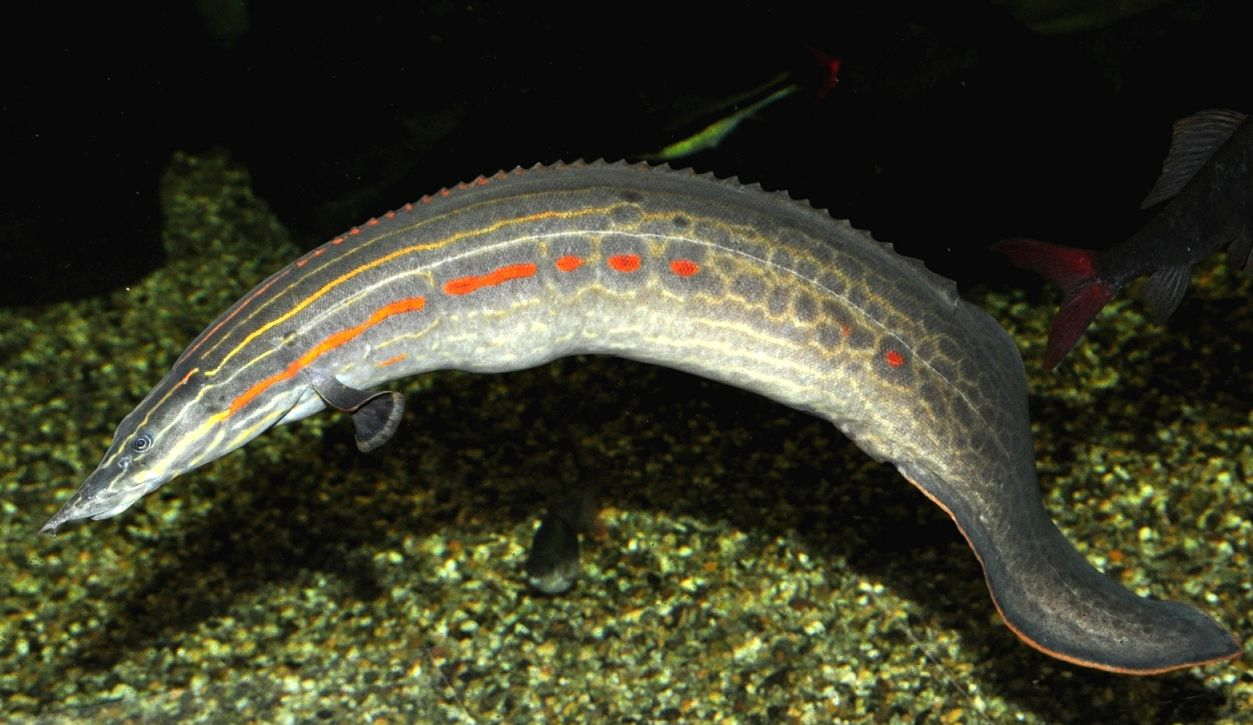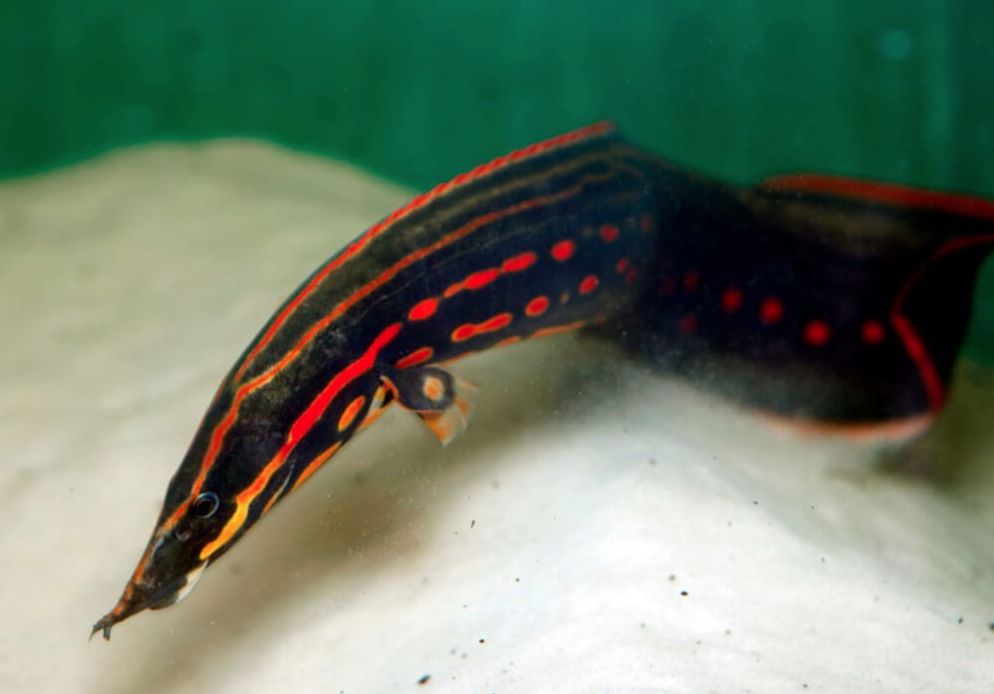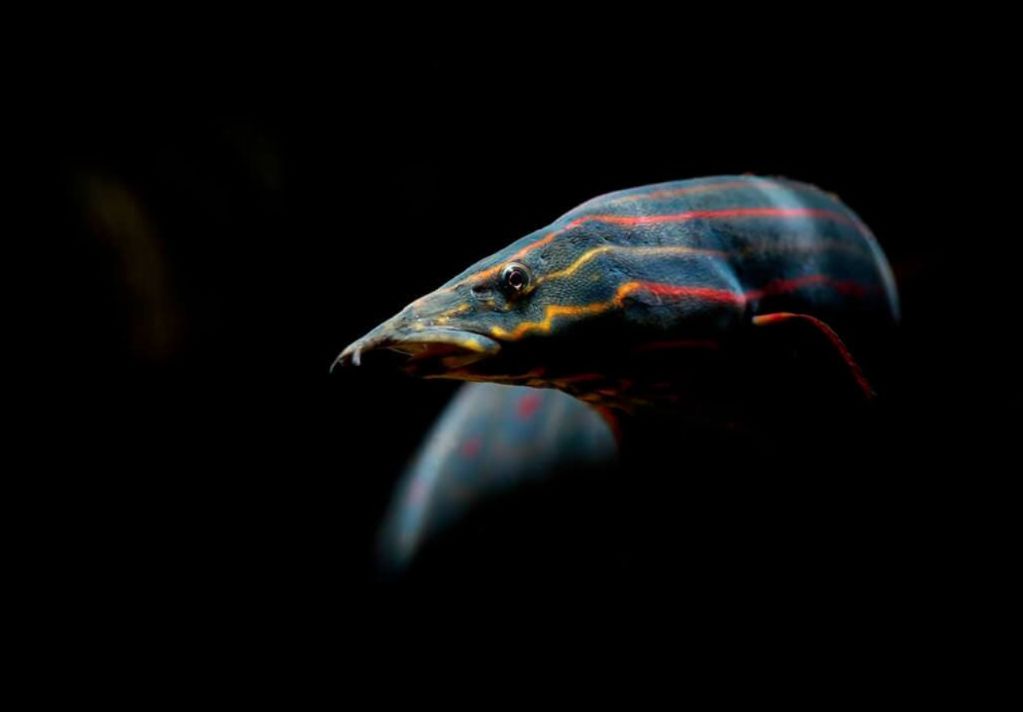Fire eel (Mastacembelus erythrotaenia) resembles a true eel, that’s why the fish got its name. However, this fish has nothing in common with eels despite its snake like body and pointed snout. This is a renown tank and commercial fish.

Contents
Habitat in the wild
Mastacembelus erythrotaenia belongs to the family Mastacembelidae. The Mastacembelidae family, commonly known as the spiny eels, consists of a group of freshwater fish species characterized by their elongated bodies, lack of scales, and the presence of small spines along their dorsal fins. This family is part of the order Synbranchiformes, which also includes other eel-like fish species such as swamp eels and spiny eels.
The fire eel (Mastacembelus erythrotaenia) is native to Southeast Asia and can be found in various countries in the region, including Thailand, Malaysia, Indonesia, and Cambodia and other countries of South-East Asia. Its natural habitat consists of freshwater environments such as rivers, streams, marshes, swamps, and flooded areas. This bottom-dwelling fish is mainly encountered in slow muddy rivers and lakes, since one of its favorite activities is to bury itself in the riverbed.
Fire eels typically inhabit slow-moving or stagnant waters with dense vegetation, submerged tree roots, rocks, and other structures that provide hiding places. They are commonly found in areas with muddy or sandy substrates where they can burrow and hide during the day.
These eels are known to prefer areas with low light levels and ample cover, as they are nocturnal creatures. They are adapted to living in the tropical climate of Southeast Asia, where they can thrive in water temperatures ranging from 75°F to 82°F (24°C to 28°C). The pH level of their natural habitat is usually slightly acidic to neutral, ranging from 6.5 to 7.5.
It’s important to note that while fire eels are native to Southeast Asia, they are also popular in the aquarium trade worldwide. As a result, they can be found in home aquariums in various parts of the world where they are provided with suitable tank conditions that mimic their natural habitat.
In Asia locals eat fire eels, therefore it is highly prized among them. However, young fishermen and aquarists don’t share this attitude because of troubles fire eel gave them with its spines on the dorsal fin.
Description
Can eels hurt you?
In general, eels are not aggressive towards humans and will not intentionally harm or attack unless provoked or threatened. But fire eel can be dangerous! When being caught the fish tries to escape as fast as possible and it may hurt the one who is holding it with its spines.Spines themselves are not poisoned, but the slime they produce is toxic. So, if a fire eel has bitten you, hurry up and apply some antiseptic to the wound. But still it is better to be careful with this fish and not to touch it.
Fire eel appearance is like the one of eel. Its elongated body is covered with small scales. The fish has big eyes. Near the anterior border of the fish eye there are its posterior nostrils.
When looking for food fire eel feels the bottom with a sensitive fleshy outgrowth on its snout. At the end of this long nose appendage there are two tubulated nostrils. Due to this peculiarity fire eel is referred to Mastacembelidae family.
The fire eel has well developed air-bladder as well as tail and pectoral fins. The dorsal is divided into two parts. Both anal and dorsal fins are narrow and long and they end near caudal fin.
Fire eel has no abdominal fins. The coloring is dark brown. There are four bright red or orange lateral stripes along the body, very often they consist of spots and small lines. The color intensity of the spots varies depending of the age and tank conditions. As a rule anal, dorsal and pectoral fins have red edges.
How big do fire eels get?
In the wild fire eel body size may reach 1 m (3.3 ft), when dwelling in a tank it is 16 to 20 inches (40 to 50 centimeters) long. In rare cases, fire eels have been reported to reach lengths of up to 3 feet (90 centimeters).
How fast do fire eels grow?
The growth rate of fire eels can vary based on several factors, including genetics, diet, water quality, tank size, and overall care. Generally, fire eels have a relatively slow growth rate compared to some other aquarium fish species. It may take several months to a year for a fire eel to grow an inch in length.
Providing a nutritious and varied diet is crucial for promoting healthy growth. Offering a diet consisting of live or frozen foods such as bloodworms, brine shrimp, blackworms, and other meaty offerings can support their growth and development.
How long do fire eels live?
Fire eels have the potential to live for a relatively long time when provided with proper care. With appropriate conditions and a suitable environment, fire eels can live for around 10 to 15 years in captivity. However, individual lifespan can vary depending on factors such as genetics, diet, water quality, and overall husbandry.
| Characteristic | Description |
|---|---|
| Scientific Name | Mastacembelus erythrotaenia |
| Common Names | Fire eel, |
| Family | Mastacembelidae |
| Native Range | Southeast Asia (Thailand, Malaysia, Indonesia, etc.) |
| Maximum Size | Up to 20 inches (50 centimeters) |
| Body Shape | Elongated and serpentine |
| Coloration | Dark brown to black with yellow/orange markings |
| Behavior | Nocturnal, secretive, burrowing |
| Habitat | Freshwater rivers, streams, marshes, swamps |
| Preferred Substrate | Muddy or sandy substrate for burrowing |
| Tank Size | At least 55 gallons (200 liters) for adults |
| Tank Requirements | Hiding places, secure lid, soft substrate |
| Water Temperature | 75°F to 82°F (24°C to 28°C) |
| pH Range | 6.5 to 7.5 |
| Diet | Carnivorous, feeds on small invertebrates |
| Lifespan | 10 to 15 years in captivity |

Difficulties in keeping
The fire eel is rather undemanding, but the fact that this is a predator fish and a large one as well imposes restrictions on keeping it in a tank. You will need at least very spacious tank with tank mates that are large enough, so the fish won’t treat them as food.

Keeping in a tank
Tank size
When planning a tank for a fire eel, it’s important to consider their potential growth and provide adequate swimming space. Fire eels can grow quite large and require a spacious tank to accommodate their size and behavior. To keep one adult species of the fish you will need a tank larger than 350 liters (77 gallons), but larger tanks are highly recommended. These eels can reach a size of around 24 to 36 inches (61 to 91 cm) in length, so a larger tank will provide them with more room to swim and explore. A tank that is 4 to 6 feet (120 to 180 cm) in length and 2 feet (60 cm) wide would be suitable for an adult fire eel.
Tank decor
Fire eel adores hiding. This fire eel is a nocturnal one. During the day it hides under snags and stones, buries itself in the tank bottom substrate and all you can see is its eyes and a snout. Since fire eels are nocturnal, it’s important to provide hiding spots in the form of caves, PVC pipes, or driftwood. This will give them a sense of security and help replicate their natural habitat.
You should make sure that there are no cracks in the tank, otherwise fire eel will easily ‘escape’ from the tank through the tiniest slit.
Substrate
Fire eels are burrowers and appreciate having a substrate that allows them to dig. Sand or fine gravel can be used as a substrate, and it should be at least a few inches deep to accommodate their natural behavior.
To replicate their natural environment, you can use the following substrates:
- Fine Sand: Fire eels appreciate a soft substrate like fine sand. It mimics the muddy or sandy river bottoms where they typically dwell. Avoid using coarse sand, as it may cause irritation to the eel’s delicate skin.
- Smooth Gravel: If you prefer using gravel instead of sand, choose a smooth variety with small particles. Smooth gravel can still provide a suitable substrate for the fire eel while allowing water to circulate effectively.
It is likely that you’ll have to forget about tank plants with roots and replace them with floating ones, because fire eel when burying itself in a sandy bottom doesn’t care about about the place, so it is quite possible that the fish will dig some tank plant roots and damage them.
Water parameters
Optimal tank water parameters are the following: temperature 24-28 °C (75-82 °F), pH 6.8-7.5, water hardness should be not more than 15°. Power aeration, filtration and regular water renew (up to quarter of the total tank volume) is a must when keeping such a fish. It also likes when there is some water flow in a tank.

Tank mates
As a rule the fire eel is timid and it ignores its tank mates, if it can’t eat them; they will eat small fishes though. Fire eel shows aggression towards its king and that’s why it’s not recommended to keep a couple in one tank. Since the fish demonstrates aggression towards its kind, you should keep it alone in a tank but it may have a company of some active and peaceful tank fishes.
Here are some suitable tank mates for fire eels:
- Peaceful community fish: Choose peaceful community fish that are not aggressive, nippy, or likely to harass the fire eel. Good options include small to medium-sized tetras, rasboras, danios, gouramis, and peaceful barbs. Ensure that the tank mates are not small enough to be considered prey by the fire eel.
- Bottom-Dwelling Fish: Fire eels are primarily bottom-dwelling fish, so selecting compatible bottom-dwellers can work well. Corydoras catfish, small loaches (such as Kuhli loaches), and certain species of small plecos (like the Bristlenose pleco) are suitable choices. These fish occupy different levels of the aquarium and can coexist peacefully with fire eels.
Diet
Fire eel can be hand feed by its owner, whom the fish starts to recognize rather quickly. The fish should be fed with any live food (for example, tubifex, bloodworm, small fishes), dry and frozen food as well.
Fire eels are carnivorous and primarily feed on live or frozen meaty foods. Their diet consists of a variety of small aquatic animals and invertebrates. In the wild this fish is a predator and it preys on insects larvae, worms, snails and even small crabs.
Here are some common food options for fire eels:
- Live or frozen Foods: Fire eels readily consume live or frozen foods such as bloodworms, blackworms, tubifex worms, brine shrimp, and daphnia. These foods provide essential nutrients and mimic the eel’s natural diet.
- Small fish: Fire eels can be offered small live or frozen fish, such as guppies, goldfish. It’s important to ensure that the fish are an appropriate size for the fire eel to consume comfortably.
- Insects and Invertebrates: They can also be fed small insects like crickets, mealworms, and earthworms. Invertebrates like small shrimps, snails, and crayfish can be occasional treats as well.
How long can a fire eel live without food?
Fire eels have the ability to withstand extended periods without food due to their natural adaptation to intermittent feeding opportunities in the wild. While the specific duration can vary depending on the individual eel’s health, age, and overall condition, fire eels can typically survive without food for several weeks to a months.
During periods of fasting, fire eels slow down their metabolism to conserve energy. They can utilize their stored body fat as a source of energy during this time. However, it’s important to note that prolonged fasting can have negative effects on their health and can weaken their immune system. Therefore, it is generally recommended to provide regular feedings and avoid unnecessarily long periods without food.
If you need to leave your fire eel without food for an extended period, it’s advisable to make suitable arrangements. For example, you can use automatic feeders or ask someone you trust to feed your eel while you’re away to ensure its well-being. Additionally, providing a balanced and varied diet before and after the fasting period is important to support their nutritional needs.
Gender differences: male vs female
Distinguishing between male and female fire eels (Mastacembelus erythrotaenia) can be challenging, as there are no distinct visual differences between the sexes. Unlike some other fish species, fire eels do not exhibit prominent external sexual dimorphism, making it difficult to determine their gender based on appearance alone.
To reliably determine the sex of fire eels, internal examination or breeding behavior analysis is typically required. This can be challenging and should only be attempted by experienced aquarists or experts.
Breeding
Fire eel is a very challenging species to breed in captivity, so it is quite a troublesome thing to do. You should use some special hormonal injections, but even after this it doesn’t guarantee that you achieve the anticipated results.
The fire eel becomes reproductive at the age of two years old. To breed this predator fish in captivity you will need a tank (of 400 liters and more capacity) with a ceramic tube in it or a net stretched over the tank bottom.
The following tank water parameters are optimal for the breeding: temperature 28-29 °C, water hardness about 10°, pH from 7 to 7.2. To create powerful aeration and filtration in the tank you should put four sprayers in different tank corners.
The breeders should be fed with live food: bloodworm, tubifex, insects larvae. The male haunts the female all over the tank and then catches her near the ceramic tube and squeezes up to 50 yellowish eggs (3 mm in diameter) from the female. In general through the whole spawning period the female lays from 700 to 1000 eggs.
When the spawning is over the fish is removed from the tank. One third of the tank water is renewed with the fresh one, lighting is decreased to its minimal value and the eggs are processed with methylene blue.
The egg stage lasts about 48-72 hours. Larvae except their yolk bag also have a gular sac (presumably in case of oxygen deficiency in water).
In 12 days the larvae starts feeding. Brine shrimp can be used as its first food. Small portions of food should be put in several places of the tank 5-6 times a day.
The juveniles grow fast – during the first month they grow to be about 4.5 cm long and at the end of the second month that are about 7 cm long. When growing juveniles you should turn of the filter to prevent them from getting injured if they get there.
Daily water renew (up to 10%) is a must. As a precaution you should disinfect the water with methylene blue (1-3 mg/l), antibiotics (up to 10 mg/l). Metabolic byproducts as well as food leftovers have to be removed as fast as possible. That’s why tanks without any bottom substrate will be a good idea in this respect.
Juveniles can be also put into ornamental tanks with bottom substrate layer that doesn’t exceed 3 cm. At that you have to turn the bottom substrate at least once in a month.
Using undergravel filters is possible only in case if false bottom is thoroughly fitted and there are not slits. At the age of two weeks the juveniles start getting their coloring – first the spots and lines appear and then the body gets darker.